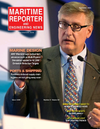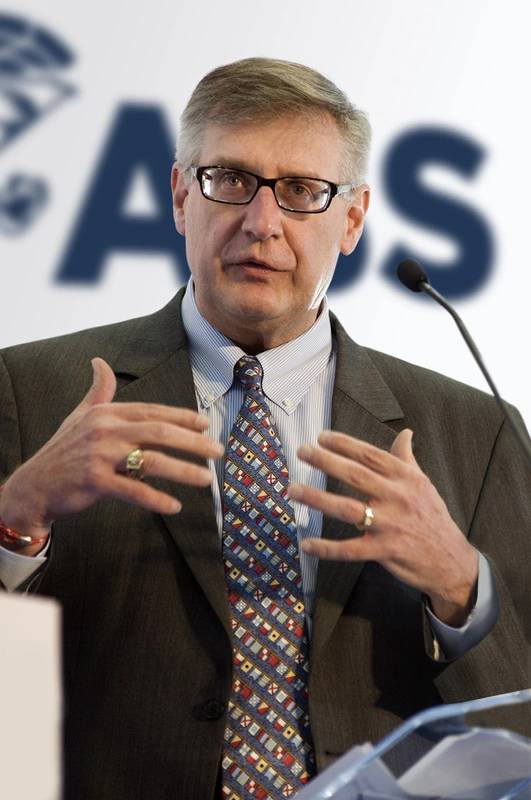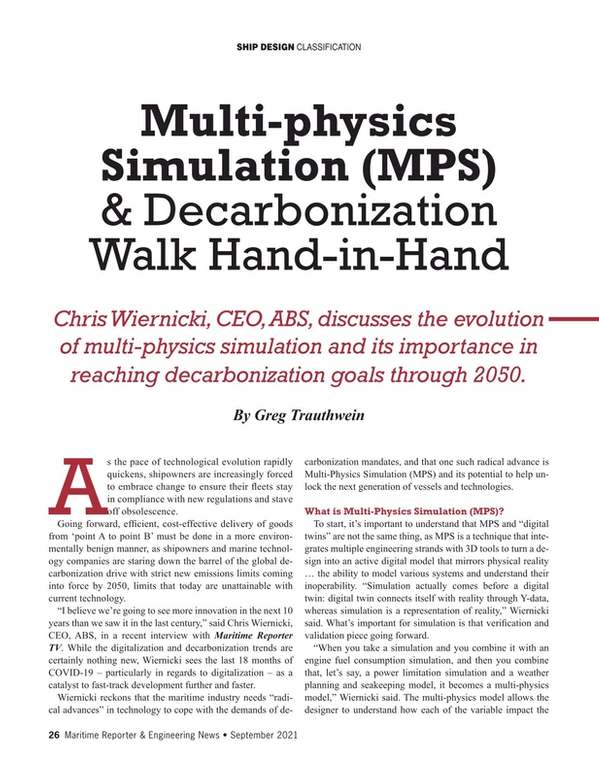
Marine Design: Multi-Physics Simulation (MPS) & Decarbonization Walk Hand-in-Hand
Chris Wiernicki, CEO, ABS, discusses the evolution of multi-physics simulation and its importance in reaching decarbonization goals through 2050.
As the pace of technological evolution rapidly quickens, shipowners are increasingly forced to embrace change to ensure their fleets stay in compliance with new regulations and stave off obsolescence.
Going forward, efficient, cost-effective delivery of goods from ‘point A to point B’ must be done in a more environmentally benign manner, as shipowners and marine technology companies are staring down the barrel of the global decarbonization drive with strict new emissions limits coming into force by 2050, limits that today are unattainable with current technology.
“I believe we’re going to see more innovation in the next 10 years than we saw it in the last century,” said Chris Wiernicki, CEO, ABS, in a recent interview with Maritime Reporter TV. While the digitalization and decarbonization trends are certainly nothing new, Wiernicki sees the last 18 months of COVID-19 – particularly in regards to digitalization – as a catalyst to fast-track development further and faster.
Wiernicki reckons that the maritime industry needs “radical advances” in technology to cope with the demands of decarbonization mandates, and that one such radical advance is Multi-Physics Simulation (MPS) and its potential to help unlock the next generation of vessels and technologies.
 “I believe we’re going to see more innovation in the next 10 years than we saw it in the last century,” said Chris Wiernicki, CEO, ABS, in a recent interview with Maritime Reporter TV. Photo courtesy ABS
“I believe we’re going to see more innovation in the next 10 years than we saw it in the last century,” said Chris Wiernicki, CEO, ABS, in a recent interview with Maritime Reporter TV. Photo courtesy ABS
What is Multi-Physics Simulation (MPS)?
To start, it’s important to understand that MPS and “digital twins” are not the same thing, as MPS is a technique that integrates multiple engineering strands with 3D tools to turn a design into an active digital model that mirrors physical reality … the ability to model various systems and understand their inoperability. “Simulation actually comes before a digital twin: digital twin connects itself with reality through Y-data, whereas simulation is a representation of reality,” Wiernicki said. What’s important for simulation is that verification and validation piece going forward.
“When you take a simulation and you combine it with an engine fuel consumption simulation, and then you combine that, let’s say, a power limitation simulation and a weather planning and seakeeping model, it becomes a multi-physics model,” Wiernicki said. The multi-physics model allows the designer to understand how each of the variable impact the design as a whole. “More importantly, as the industry looks at where we are now relative to future-proofing, it allows us to look at the impact of electrification, for example, or an alternate fuel. It allows us to look at the impact of batteries. Looking at the impact of certain decisions made on voyage performance, relative to hull resistance, relative to alternative fuels. So MPS is a technology that allows us to, with confidence, digitally touch where things are, allowing us to shape a framework and pathway going forward.”
The value of MPS increases exponentially as it enables new concepts in design, engineering and operations to be assessed while a vessel is in its formative stage, helping to make changes in design – from the simple to the radical – very early on in the process. Logically, this helps to dramatically cut development costs and accelerate the time of the design from inception to delivery. In addition, bringing the matter full circle and into the wheelhouse of classification, MPS is an enabling technology that will eliminate paper drawings from the workflow altogether, enabling totally digital classification.
While MPS is a digital solution, it sits at the center of the ‘future fuels’ conversation, too. Wiernicki reasons that alternative fuels lie at the heart of all future vessel design, and the ability to efficiently test how different fuels will ultimately impact a ship’s final design look and function will be dramatically enabled by MPS, to understand not only the vessel modification requirements, but to also catch in advance any unintended safety consequences premised on fuel choice.
“When you look at the complexity and you look at the significant increase of system interconnectivity, you begin to ask yourself, how am I going to really understand and begin to rationalize what is going on?” Wiernicki said. “This is where simulation comes in. It’s an engineering technology that allows us to visualize the interconnectivity of various cyber-enabled physical systems.”
“We can all understand the potential of alternate fuels in shipping’s push to achieve a sustainable footing,” Wiernicki said. “However, at ABS we see the potential of MPS, sitting as it does at the intersection of data, digital and decarbonization, as another, less heralded, advance with the potential to make a significant contribution.”
2050 or Bust
Wiernicki and his ABS team are bullish on the potential for MPS to make a meaningful impact in helping shipowners hurdle the challenges ahead.
“Imagine being able to run a digital model of an asset through a digital model of an experience and, informed by an immense amount of well-chosen, comprehensive and appropriate data on many factors such as ship structures, machinery behavior and ocean forces, obtain a rigorously accurate picture of what is most likely to happen to that asset in real life,” Wiernicki said. “Today MPS is on the cutting edge of resolving decarbonization and efficiency challenges, but in a not-too-distant tomorrow it will be a legacy component of a new technology that can provide such a degree of insight and understanding as to enable us to truly maximize vessel efficiency, environmental protection and safety at sea.”
He said meeting the emissions reductions challenges of 2030 is feasible with today’s technology, but 2050 is “a story that has not been written.”
And even though the technologies and fuels don’t exist today to get to the 2050 emission levels, the ships that are currently being designed and built using, for example, liquefied natural gas (LNG) as fuel, must be looked at through the lens of future proofing them for conversion to hydrogen, liquefied petroleum gas (LPG), ammonia or biodiesel.
“I am convinced going forward that the chief technology officer and the chief financial officer are going to be sitting next to each other in the boardroom, really trying to assess the commercial risks of developing technology more so now than ever before.”
At the end of the day, MPS, future fuels, digitalization and everything else intertwined comes down to managing risks effectively and efficiently. “So, what we’re really looking is to find a little bit more clarity, a little bit more definition to some of these swim lanes, so we can as an industry collectively begin to really focus in on making the right investment decisions going forward,” Wiernicki said.
Rather than physically testing everything, you’re able to form an “ultimate testing envelope,” said Wiernicki, and this virtual testing envelope is particularly important when you’re talking about technologies that either have not been developed or are not yet scalable. “What simulation does is it gives you a very cost-effective way to begin to understand where you should be focusing your priorities. In the case of ABS, it is going to be all about helping us understand where are those unintended safety consequences. It’s no longer going to be component-by-component. Simulation gives you that framework to be able to do that.”
Calling it a “digital sixth sense to help us continue to do what we do well,” Wiernicki noted, “We are a safety centered organization.”
Simulation is a point of investment for ABS today and in the future, with a new Simulation Center of Excellence in Singapore underway, and more to come around the world. “Just about every one of our joint development projects, whether it’s with a yard, an owner or an equipment manufacturer has some level of simulation embedded in it,” Wiernicki said. In fact, he sees simulation and MPS as central to ABS’ evolving role. “It allows us, to some extent with our data analytics capability, to even predict things going forward. It allows us to begin to extend our classification role to something even furthermore like an integrator, an assessor, a predictor, that go-to solutions advisor to help the industry.”
And with the myriad of challenges ahead, shipowners will need all of the resources they can muster.
“As we moved to 2050, that story hasn’t been written yet. We’re going to need to visually simulate so we understand what is going on. The automotive and the aerospace industry taught us the science of simulation. What we want to do right now in the maritime sector is begin to apply that.”
Read Marine Design: Multi-Physics Simulation (MPS) & Decarbonization Walk Hand-in-Hand in Pdf, Flash or Html5 edition of September 2021 Maritime Reporter
Other stories from September 2021 issue
Content
- A BC Ferries Case Study: Lessons Learned in Setting Underwater Radiated Noise Targets page: 22
- Marine Design: Multi-Physics Simulation (MPS) & Decarbonization Walk Hand-in-Hand page: 26
- PROFILE: Glosten is Meeting the Decarbonization Challenge, by Design page: 36
- Supply Chain Shocks: Ocean Shipping Challenges Abound page: 44
- Marine Biofouling in Ports: Wet Docks Acting as ‘Hot Spot’ Biofouling Transfer Stations page: 50


